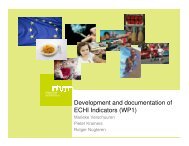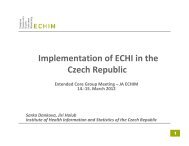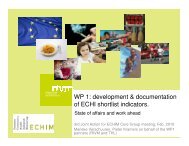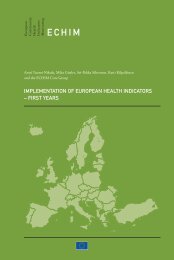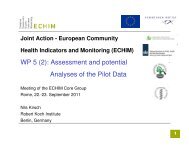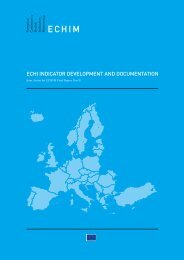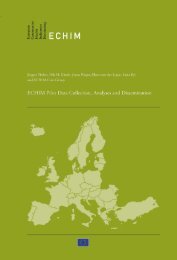INDICATORS
ECHIM Final Report
ECHIM Final Report
You also want an ePaper? Increase the reach of your titles
YUMPU automatically turns print PDFs into web optimized ePapers that Google loves.
Calculation:<br />
1) European Injury Database (IDB): the number of accidents recorded in the sample of<br />
hospitals participating the IDB project; the number of cases extrapolated at national level;<br />
expressed as the number of accidents per 1000 inhabitants.<br />
2) Number of respondents having had a home and leisure accident during the past 12<br />
months, derived from EHIS: question HS.7 and HS.8: HS.7 In the past 12 months, have<br />
you had any of the following type of accidents resulting in injury (external or internal)?<br />
4. Home and leisure accident (yes / no). If yes: HS.8 Did you visit a doctor, a nurse or<br />
an emergency department of a hospital as a result of this accident? (Yes, I visited a doctor<br />
or nurse / Yes, I went to an emergency department / No consultation or intervention was<br />
necessary).<br />
3) Hospital treated injuries due to home and leisure accidents. Based on hospital discharges.<br />
WHO-HfA has “Hospital discharges, injury and poisoning per 100 000” (chapter XIX of<br />
ICD-10). EUROSTAT has Hospital discharges due to injury, poisoning and certain other<br />
consequences of external causes (S00–T98). Further work needed.<br />
Notes: Often the incidence rates are presented as 3-year average rates. EHIS does not<br />
discriminate between causes of accidents, but IDB does, in a very detailed way. Hospital<br />
discharges (greatly) underestimate the number of accidents at home and/or freetime.<br />
30. INJURIES: ROAD TRAFFIC<br />
Definition: Incidence of persons injured in road traffic accidents. A road traffic accident is<br />
any accident which occurred or originated on a public road/street or on a private road to<br />
which the public has right of access, in which at least one moving vehicle has participated<br />
and which resulted in one or more persons being injured. Injured means any person who<br />
was not killed but sustained one or more serious or slight injuries as a result of the accident.<br />
Hospitalisation or medical treatment not necessarily required.<br />
Calculation:<br />
1) OECD: Number of people injured in road traffic accidents per 100 000 persons. Road<br />
traffic accident is an accident which occurred or originated on a way or street open to public<br />
traffic and resulted in one or more persons being killed or injured, and at least one moving<br />
vehicle was involved. Injured means any person who was not killed but sustained one or<br />
more serious or slight injuries as a result of the accident.<br />
2) WHO: Road traffic accidents with injury per 100 000 persons (indicator 3150; 110301)<br />
3) Proportion of respondents having had a road traffic accident during the past 12 months,<br />
calculated from EHIS questions HS.7 and HS.8: HS.7 In the past 12 months, have you<br />
had any of the following type of accidents resulting in injury (external or internal)? 1. Road<br />
traffic accident (yes / no). HS.8 Did you visit a doctor, a nurse or an emergency department<br />
of a hospital as a result of this accident? (Yes, I visited a doctor or nurse / Yes, I went to an<br />
emergency department / No consultation or intervention was necessary).<br />
Notes: Often the incidence rates are presented as 3-year averages. The indicator is meant to<br />
deal only with non-fatal events, since deaths from traffic accidents are under the 65 causes<br />
of deaths. Road traffic accidents should include drivers and passengers of motorised vehicles<br />
and pedal cycles as well as pedestrians. Seriousness of the accident: fatal – injury – serious<br />
injury – slight injury (OECD, CARE).<br />
101



